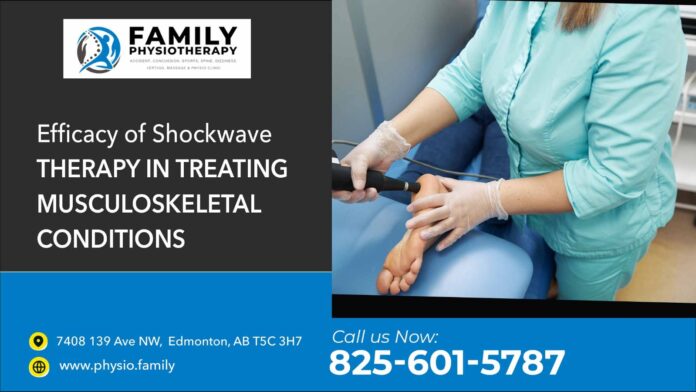The effectiveness of shockwave therapy in addressing various musculoskeletal conditions has been noteworthy, warranting its incorporation into the treatment repertoire at Family Physiotherapy Edmonton. This article unpacks the therapeutic benefits of shockwave therapy and how it shapes the rehabilitation process, offering renewed hope for patients and therapists alike. Join us as we navigate through the components of shockwave therapy, highlighting its efficacy, operational mechanisms, and its utility in managing musculoskeletal conditions.
Introducing Shockwave Therapy
Extracorporeal shock wave therapy, more commonly known as shockwave therapy, employs pressure waves to invigorate the body’s natural repair systems, especially beneficial in regions with low circulation or damaged tissue. Initially utilized in the realm of urology for kidney stone treatment, its success in mitigating pain and fostering tissue regeneration has paved the way for its application in physiotherapy.
The Science Behind Shockwave Therapy
Shockwave therapy, a non-surgical treatment methodology, uses the application of sound waves to injured body parts to instigate healing. The sound waves, or high-energy acoustic waves, are produced electronically, then passed through the skin’s surface and disseminated radially within the body.
The principal method through which shockwave therapy supports recovery is neovascularization. The high-energy acoustic waves induce micro-trauma, sparking the body’s innate healing response. This chain reaction leads to the secretion of angiogenic factors, culminating in the formation of new blood vessels in the treated region. This improved blood circulation heightens the supply of oxygen and nutrients to the tissues, hastening healing and recovery.
The shockwaves are also potent in breaking down soft tissue calcification. Moreover, these waves activate the release of certain pain mediators and stimulate nerve fibres, consequently reducing pain perception.
Employing Shockwave Therapy in Musculoskeletal Conditions
The use of shockwave therapy spans a variety of musculoskeletal conditions, a testament to its adaptability and widespread relevance in managing multiple musculoskeletal issues.
-
- Plantar Fasciitis
- Tennis Elbow (Lateral Epicondylitis)
- Achilles Tendinopathy
- Rotator Cuff Tendinitis
- Patellar Tendinopathy (Jumper’s Knee)
- Calcific Tendinitis
- Golfer’s Elbow (Medial Epicondylitis)
- Bursitis
- Shin Splints
- Scar Tissue Treatment
- Stress Fractures
- Enhancement of Bone Healing
- Non-Healing Ulcers
- Non-Healing Wounds
- Morton’s Neuroma
- Hallux Rigidus
- Iliotibial Band Syndrome
- Carpal Tunnel Syndrome
- Dupuytren’s Contracture
- Trigger Finger
- Plantar Plate Tear.
Effectiveness of Shockwave Therapy
The extent to which Shockwave Therapy helps varies depending on the condition, the severity of the patient’s symptoms, and individual factors like overall health and adherence to the treatment plan. However, in general, shockwave therapy has substantial efficacy.
For acute conditions, shockwave therapy can often provide immediate relief, reducing pain and inflammation in a matter of sessions. This can be instrumental in allowing patients to commence or resume physical therapy and rehabilitation exercises without excessive discomfort, speeding up the overall recovery timeline.
In the case of chronic conditions, the benefits of shockwave therapy might take longer to become apparent but can be profoundly impactful. By stimulating the body’s natural healing processes and improving blood flow to the treatment area, shockwave therapy can gradually alleviate chronic pain, improve mobility and functionality, and enhance quality of life.
For instance, in plantar fasciitis, one of the most common causes of heel pain, patients experience significant improvement after shockwave therapy. In conditions like calcific tendonitis of the shoulder, shockwave therapy can break down calcific deposits, leading to a reduction in pain and improvement in shoulder function.
Additionally, shockwave therapy is a non-invasive treatment, meaning it doesn’t carry the same risks as surgical interventions, such as infection or complications from anesthesia. This makes it a suitable treatment option for a broad spectrum of patients, including those who might not be candidates for surgery.
Experiencing Shockwave Therapy: Patient’s Perspective
The efficiency and tolerability hallmark the patient experience with shockwave therapy. Despite the sound of high-energy acoustic waves, the treatment process is generally brief and triggers only slight discomfort rather than severe pain.
The protocol commences with a physiotherapist applying a gel to the area targeted, ensuring effective transmission of the shockwaves. Once the therapy is initiated, patients may experience a throbbing or tapping feeling as the shockwaves permeate the affected tissues. This sensation can be coupled with minor discomfort, which is usually well-managed.
Many patients disclose immediate relief post-treatment, attesting to the rapid efficacy of this therapy. As the treatment triggers the body’s intrinsic healing processes, relief from pain and functional restoration progressively improve over time.
Typically, each session spans approximately 15-20 minutes, making it a viable treatment choice even for those with hectic schedules. Physiotherapists will maintain a close eye on comfort levels and modulate the shockwave intensity if required, ensuring the procedure is as patient-centred as possible.
Integrating Shockwave Therapy into a Holistic Treatment Plan
Shockwave therapy Edmonton, is not employed as an independent treatment. It is incorporated into a holistic treatment plan, which could include manual therapy, exercises, and education. This multi-pronged strategy ensures that every aspect of a patient’s recovery is attended to, leading to more effective and sustainable results.
Conclusion
The adoption of shockwave therapy at Family Physiotherapy in Edmonton reflects their dedication to utilizing potent treatments in their practice. The pursuit and integration of evidence-based treatment modalities to enhance patient outcomes and expedite recovery remain ongoing. The application of shockwave therapy Edmonton for musculoskeletal conditions demonstrates their patient-oriented approach, solidifying them as a trustworthy provider of physiotherapy services.




